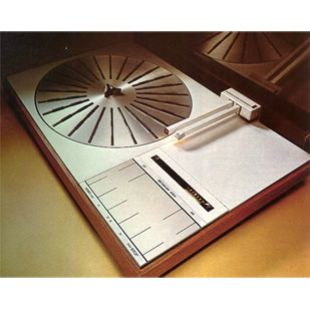
BeoGram 4002
The replacement for the Beogram 4000, this deck actually existed in a number of forms, the first using the AC motor of the 4000 and later ones using a DC motor. Simplified compared to the 4000, it was cheaper to produce, if not buy, but maintained a very similar performance. In terms of concept, performance […]
Overview
The replacement for the Beogram 4000, this deck actually existed in a number of forms, the first using the AC motor of the 4000 and later ones using a DC motor. Simplified compared to the 4000, it was cheaper to produce, if not buy, but maintained a very similar performance.
In terms of concept, performance and technical design, this record player was very much ahead of its time. All functions were governed by computer-like logic circuits. You just pressed START, that was all. Through the unique detector arm (parallel to the pickup arm) these circuits could judge the size of the record, determine its normal playing speed and instruct the pick-up arm to lower the stylus into the lead-in groove. Within a few seconds you would hear the music. If there was no record on the platter the stylus could not be lowered, so the system was safe as well as simple.
Records could be tracked more accurately because the tangential arm traced a straight line from the record’s edge to its centre, instead of tracing an arc as radial arms do. This method entirely eliminated inward bias (skating effect) and tracking angle error was almost non-existent.
The naked elliptical diamond stylus in the MMC 20EN (former MMC 4000) pickup cartridge helped ensure that Beogram 4002 got all of the information out of your record grooves while handling them in the gentlest possible way.
Bang & Olufsen’s Beogram 4002 turntable was awarded the ‘Gold Sim 74’ and ‘Top Form 74’ prizes in the category of electro-mechanics.
Beogram 4004/4002 could be made up as part of the Beosystem 4400 or the quadraphonic Beosystem 6000 when linked together with other compatible Bang & Olufsen products.
Beogram 4004/4002 was an electronically controlled stereo record player with tangential arm. The unit utilised a belt drive system to control the record deck. Thanks to the incorporation of advanced electronics, several advantages were gained from this new concept in record-players: high specification, supreme automation of all functions and the most gentle treatment of records. The tangential arm moved the pick-up in a straight line towards the centre of the record, reducing tracking error to a mere 0.04%. The record player was fitted with the MMC 4000 pick-up cartridge (later MMC 20EN) which had a frequency range of 20-25.000 Hz ±1.5 dB. It had an integrated, elliptical naked diamond stylus with a stylus pressure of 1g. Rotation of the turntable was governed by a synchronous motor which was power-driven via a stabilised oscillator which made it independent of mains voltage and frequency fluctuations. Wow and flutter was less than ± 0.05 % and rumble better than 65 dB. DIN B weighted. A photocell in the record-player’s second arm registered the size of the record and the speed at which it should be played. Advanced electronics governed the actions of the pick-up arm: lifting, lowering, etc. However, the record-player could be operated manually by use of the large “easy-touch” control plate. Operation of the record deck was very easy as all functions were governed by computer logic circuits. With its tangential detector arm that was parallel to the linear tracking tonearm, the unit could sense the size and speed of the record to be played and lowered the stylus into the lead-in groove. It had cueing controls to raise and lower the tonearm to where you wanted it on the record. If there was no record on the turntable and you pushed START, it would not lower the stylus on the turntable. Manual selectors to determine the speed of the record player were incorporated; however, the turntable was fully automatic so all you had to do was put on the record and press START.
Beogram 4004/4002 was fitted with a hinged dust lid which could be opened to any angle up to about 60 degrees or completely removed by easy sliding action.
Product Details
Software
No software information available.
Product Specification
5501 (1974 - April 1976)
5511 (1976 - Feb 1978)
5521 (1977 - June 1980)
GB 5504 (1974 - April 1976)
GB 5514 (1976 - Dec 1977)
GB 5524 (1977 - June 1980)
USA 5503 (1974 -April 1976)
USA 5513 (1976 - Feb 1978)
USA 5523 (1977 - April 1980)
Sound system Stereo, matrix
Output 2 x 0.6 mV
Speeds 33 – 45 rpm.
Tonearm: Tangential
Automatic record-size: Yes
Automatic pickup movement: Yes
Automatic speed selection: Yes
Wow and flutter DIN: < +/- 0.05 %
Rumble DIN unweighted: > 45 dB
Rumble DIN weighted: > 65 dB
Speed deviation: < 0.02 %
Speed control range: > 6 %
Dial for speed: 2 pointers
Stylus pressure range: 0 – 1.5 g
Tangential tracking: < 0.04°
Lift system: Electronic
Antiskating: Parallel tracking, error angle
Motor: Servo controlled DC
Drive system: Belt
Turntable 30cm / 1.3 kg
Power supply: 110 – 130 – 220 – 240 V
Power consumption: 20 W
Dimensions W x H x D: 49 x 10 x 38cm: Weight: 11 kg
Pickup: MMC 4000
Stylus: elliptical naked diamond
Radius of curvature: 5 x 17 µm
Frequency range: 20 – 25,000 Hz +/- 1.5 dB
Recommended stylus pressure: 1g
Downloads
Type | Language | Type | Type | |
User Guide | EN | BeoGram 4002 User Guide | ||
Assembly Guide | EN | BeoGram 4002 Assembly Guide | ||
Specification | EN | BeoGram 4002 Specification | ||
Service Manual Part 1 | EN | 5501,5502 | BeoGram 4002 Service Manual | |
Service Manual Part 2 | EN | 5501,5502 | BeoGram 4002 Service Manual | |
Service Manual | EN | 5501, 5504 | BeoGram 4002 Service Manual | |
Service Manual | EN | 5503 | BeoGram 4002 Service Manual | |
Service Manual | EN | 5513, 5523-5526 | BeoGram 4002 Service Manual | |
Service Manual | EN | 5514, 5515 | BeoGram 4002 Service Manual | |
Service Manual | EN | 5524-5527 | BeoGram 4002 Service Manual |
Photo Gallery
No gallery images.
Frequently Asked Questions
No FAQs available.






